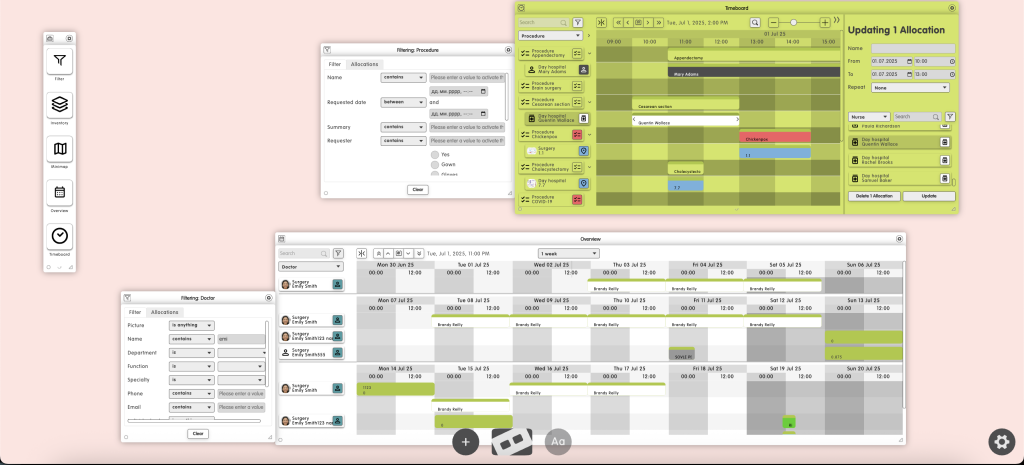CRM systems can be amazing, but they aren’t designed to help with everything. While everyone likes to talk about customer centricity, sometimes it takes resource-centric approaches to achieve it by managing real-time scheduling, inventory tracking, or resource coordination. Lionwood.software collaborated with the Swiss company Dizmo on their platform Planisy, which is an excellent example of how lean but carefully designed solutions can be tailored to multiple industries like healthcare and services and help solve operational challenges in ways that standard CRMs can’t.
The operational gap: what CRM systems miss
At the dawn of the digital revolution, CRM developers tried to make their products fit as many functionalities as possible, keeping them under one hood. At a certain point, as the possibilities of what could potentially be digitized multiplied, the “customer relationship” part that defined this type of system in the first place became complicated enough on its own, and the rest of operational processes became more of an addition.
However, as excellent as CRM systems are for managing contacts, marketing pipelines, and sales workflows, it is not always a good idea to build the operations around this. In industries like healthcare or services, performance (and true customer centricity) depends much more on efficient scheduling, staff coordination, and inventory than what a typical CRM can manage dynamically enough.
And this incurs costs. For example, in healthcare, no-shows range from 19 to 30% depending on the clinic, costing the US healthcare system around $150b each year. Standard CRMs — without integrated scheduling, inventory management, or staff availability checking — aren’t just insufficient, they’re potentially damaging to efficiency, profitability, and user satisfaction.
Meanwhile, there’s often need to schedule multiple resources: not just professionals doing the job, but the what and the where – i.e., rooms, equipment, and transfers, based on real-time availability. Healthcare settings need to manage medical supplies, expiration dates, and batch tracking. Service companies may need to prepare specific toolkits per appointment. Most CRMs lack any kind of inventory management system or logistical planning functionality.
Only 23% of CRM users rate the tools as intuitive for daily operational tasks, while 32% say their CRM is poorly suited to their specific workflows. And this is where you either tinker with the CRM to customize it ad infinitum, or look around and define what aspects of your workflows you’d rather have a dedicated system for.
Healthcare and services industries and their special needs
Several industries, including healthcare, but also miscellaneous professional services, have an important thing in common: they operate in resource-intensive environments and rely on synchronizing multiple resources at a time. Many of their services are also time-sensitive, so the role of scheduling is very high.
In healthcare, nearly 82% of outpatient appointments involve the coordination of at least two or more resources — such as a physician and medical equipment. Similarly, field service firms report that 65% of failed appointments stem from lack of proper resource availability — not technician absence, but tools, parts, or vehicles not being where they should be.
Meanwhile, missed or delayed appointments cost providers an average of $150 per event — losses that compound without automated rescheduling and availability syncing. Underutilized technicians cost companies 10–20% in revenue leakage annually.
Stakes are even higher in healthcare. A single misallocated operating room can cost a hospital over $2,500/hour. None of these are problems CRMs are built to solve, so in many cases, it pays off to have a separate system that will allow instantaneous adjustments and availability updates.
Building cross-industry scheduling platforms
While industries differ, their fundamental needs overlap: managing time-bound services, allocating resources (staff, rooms, equipment), handling no-shows and cancellations, and reporting usage and trends. So a dedicated platform will leverage this shared backbone and builds in configurable features that can adapt to each sector. For example:
- In healthcare, you might book recurring physiotherapy sessions, with specific therapists and equipment.
- In wellness and fitness, studios need to manage classes, room availability, and rotating instructors.
- In field services, dispatchers must account for travel, equipment stock, and technician availability.
Rather than building a tool from scratch for each domain, modern platforms are designed around a modular architecture — with customizable workflows, permissions, and even terminology (e.g., “patients,” “clients,” or “jobs” depending on the industry).
By combining role-based access, multi-location support, and real-time availability views, cross-industry platforms can serve a one-person clinic or a nationwide service provider equally well. According to Accenture, companies that adopt flexible scheduling platforms report up to 25% faster booking processes and 30% reductions in resource underutilization across verticals.

Planisy case
This is where the Planisy platform is a nice illustration – a project by Dizmo we at Lionwood.software have had the pleasure to collaborate on. This is a resource-centric scheduling and management platform that is designed to handle complex time- and resource-based operations.
The idea behind Planisy is that at the most abstract level, operations involve managing several aspects:
- People,
- Locations,
- Tasks,
- Events,
- Inventory and machinery,
- Transportation.
The names and details of each may change with the industry and company type, but the fundamental idea is to manage interdependencies between them in real-time visualizations. In this way, users see who or what is available, when, and for how long, thus avoiding overbookings or idle time. This is a major differentiator from traditional CRM systems, which focus more on customer contact data and less on real-world logistics.
The approach taken here is that of a clean, visual-first interface. The calendar grid (which can be displayed by different measures of time, from 1 minute to a year) displays a color coded timeline showing people, rooms, and equipment. Updates can be made through basic drag-and-drop, while the system will track dependencies.
In addition to that, there are filters to narrow views by location, type of service, or resource group. Updates are displayed in real time. If a user tries to schedule overlapping appointments or overbook a resource, Planisy provides immediate visual warnings and suggestions for resolution.
Since the system is as intuitive as possible, it doesn’t require training, which makes onboarding unusually short, typically lasting a few hours.
Lionwood.software collaborated on the development of a number of entities in the system, which could be implemented with JS, except for the admin panel that required Angular. Overall, the solution is very lean and this is where the strength lies: the convenience and robustness that time-sensitive scheduling requires comes from this.
Main takeaways
The emergence of platforms like Planisy is quite indicative of how much emphasis is now placed on optimizing operations from within. Interestingly, we’ve finally reached the point in the digital revolution where lean and intuitive solutions win out by providing more immediate value. Whether you’re managing physiotherapy sessions, technician dispatch, or rotating instructors, investing in a purpose-built solution over a repurposed CRM can lead to significantly better performance, scalability, and customer satisfaction.
If you are interested in developing similar solutions, or considering adapting digital products to make them fit into different paradigms and operational models, we at Lionwood.software are ready to apply our expertise. Contact our team for a kick-off consultation and start the discovery phase of your future perfect solution.












